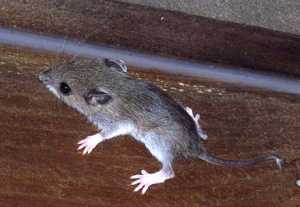
10 Jul More Acorns = More Mice = More Lyme Disease

The white-footed mouse has been found to be a competent reservoir for the Lyme disease-causing spirochete, Borrelia burgdorferi – Wikipedia image
MedicalResearch.com Interview
Richard S. Ostfeld, PhD
Distinguished Senior Scientist
Cary Institute of Ecosystem Studies
Millbrook, NY 12545, USA
MedicalResearch.com: What is the background for this study? What are the main findings?
Response: Lyme disease and other tick-borne infections occur in large portions of the eastern and Midwestern United States and adjacent Canada, and the geographic range is expanding rapidly, engulfing new communities every year. Despite the observed increases in incidence rates and geographic range at the national level, considerable variation occurs across space and time, with persistent hot spots, colder spots, bad years, and not-as-bad years. We undertook this long-term study (19 years) to ask what causes some places and years to be particularly risky and others not as risky, in terms of human exposure to tick-borne disease. Because diagnosis and treatment of Lyme disease are problematic and highly controversial, and because no vaccines or effective tick-control methods are currently available, we hoped that understanding the causes of high risk would facilitate prevention of human exposure.
We found that, in the oak-dominated forests that pervade the Lyme-disease-endemic zone, acorn production in the autumn is a strong leading indicator of Lyme disease risk two summers later. Acorn production is associated with marked population increases of white-footed mice and eastern chipmunks, which use abundant acorns as a key over-winter food source, leading to population growth the following year. Dense summer populations of mice and chipmunks provide the local population of blacklegged ticks with abundant sources of blood-meal hosts. These small rodents are more permissive of successful tick feeding (other hosts kill many ticks by grooming them as they attempt to feed), and they are also the primary natural reservoirs of infection with the microbial agents causing Lyme disease, anaplasmosis, and babesiosis. Larval ticks emerging when rodents are highly abundant are highly likely to survive and acquire infection, molting the next year into infected nymph-stage ticks. Bites from nymph-stage ticks are responsible for the great majority of tick-borne disease cases. The one-year lag from acorns to rodent populations plus the one year lag from larval ticks biting rodents to nymphal ticks biting people together are responsible for the total two-year lag.
By using motion-sensitive cameras set in over 100 sites over two years, we were also able to ask whether the local community of mammal predators can affect human risk of exposure. We found that sites with a diverse assemblage of predators, especially foxes, bobcats, and opossums, were associated with reduced tick infection prevalence with the agents of Lyme disease, anaplasmosis, and babesiosis. When these predators were absent, which sometimes occurred when coyotes displaced them, infection prevalence was significantly higher. Infection prevalence was also lower in sites within extensive, unbroken forest, and higher in sites with small forest remnants. Taken together, we determined that an understanding of the food webs within which ticks and pathogens dwell can strongly facilitate the ability to predict when and where risk will be high. Acorns exert what ecologists call a “bottom-up” effect, whereas the predators enforce “top-down” control. We found that the ticks were remarkably resilient to most weather-related factors. However, when winter-spring weather was particularly warm and dry, tick abundance the following summer was reduced. Cold winters did not kill off the ticks.
MedicalResearch.com: What should readers take away from your report?
Response: The ecology of tick-borne disease is incredibly complex, but still we can find big signals amongst the noise and predict risk with a good degree of confidence. Predicting times and places of enhanced risk is particularly important given the frustrations within the public health community and the public at large over the slow pace of progress in improving diagnostic capabilities and treatments. We are still relying fundamentally on individual efforts to prevent exposure using various self-protections, such as repellents, tick-checks, protective clothing and the like. Targeting these efforts to times and places where risk is particularly high should help protect public health.
MedicalResearch.com: What recommendations do you have for future research as a result of this work?
Response: Long-term monitoring of tick populations is crucial for evaluating the importance of ecological variables, like wildlife abundance and weather, in determining risk of human exposure. In addition, the longer we monitor these variables the more likely we are to see extreme events, which might play outsized roles. Intensive monitoring like this is also crucial for detecting invasions by other species of tick that are important to public health. For instance, we expect lone star ticks to invade our area from the south, with unpredictable consequences for blacklegged ticks and human health. We are also concerned about potential invasions by non-native ticks, like the long-horned tick that was recently detected in several eastern and Midwestern states to our south.
No disclosures
Citation:
Richard S. Ostfeld, Taal Levi, Felicia Keesing, Kelly Oggenfuss, Charles D. Canham. Tick-borne disease risk in a forest food web. Ecology, 2018; 99 (7): 1562 DOI: 1002/ecy.2386
[wysija_form id=”3″]
The information on MedicalResearch.com is provided for educational purposes only, and is in no way intended to diagnose, cure, or treat any medical or other condition. Always seek the advice of your physician or other qualified health and ask your doctor any questions you may have regarding a medical condition. In addition to all other limitations and disclaimers in this agreement, service provider and its third party providers disclaim any liability or loss in connection with the content provided on this website.
Last Updated on July 10, 2018 by Marie Benz MD FAAD
